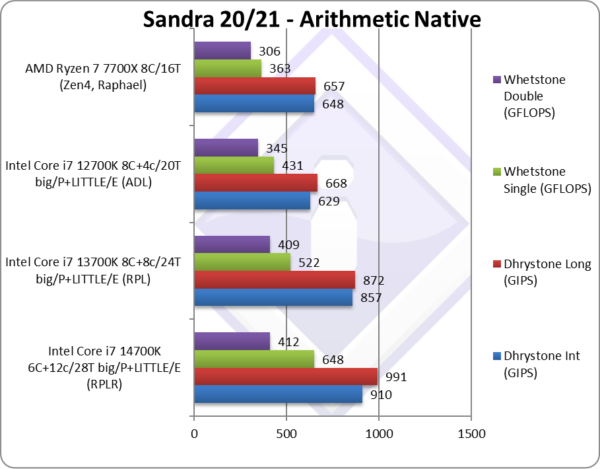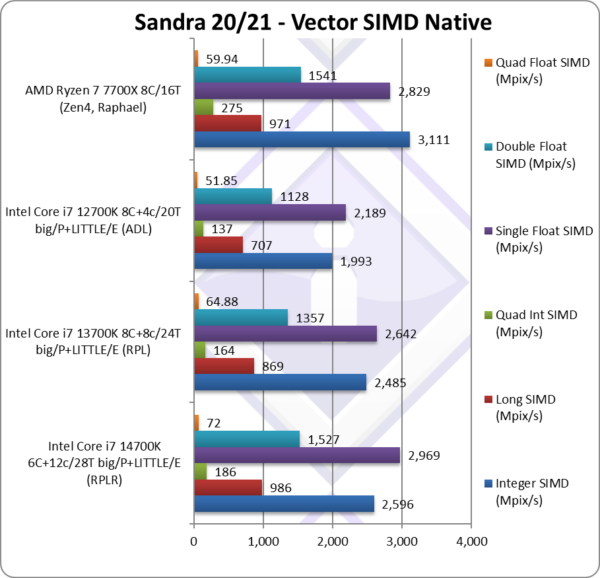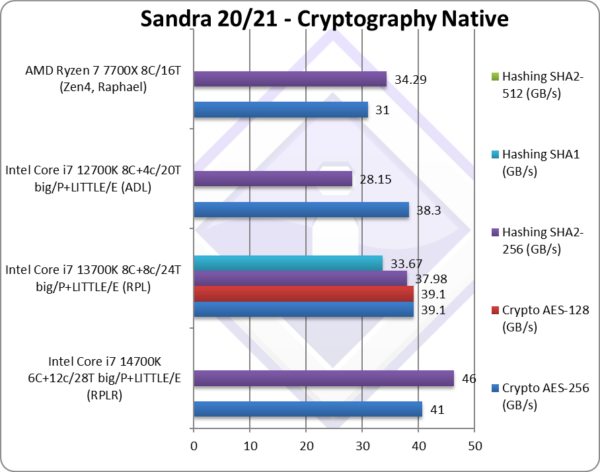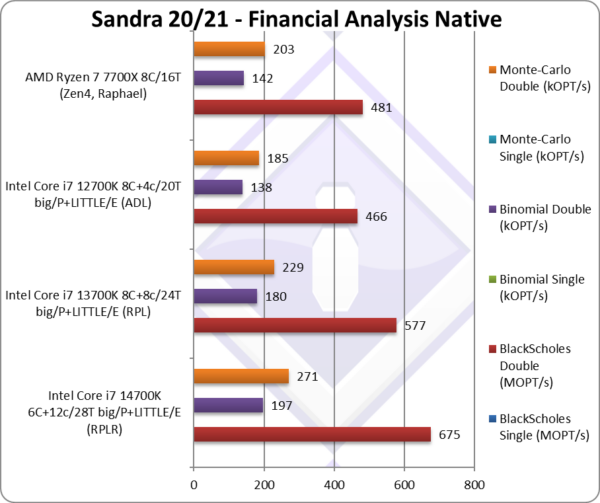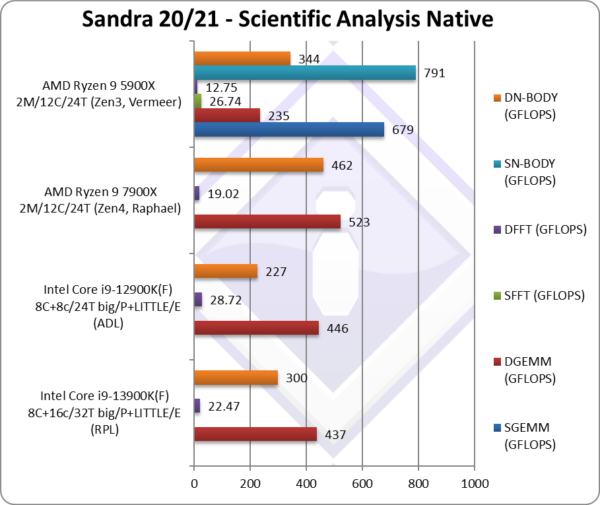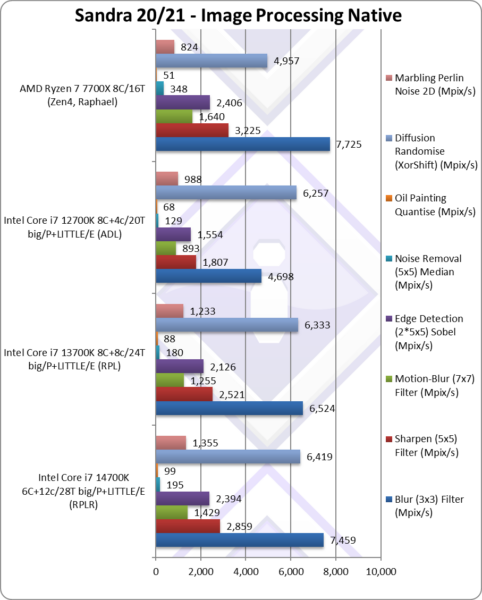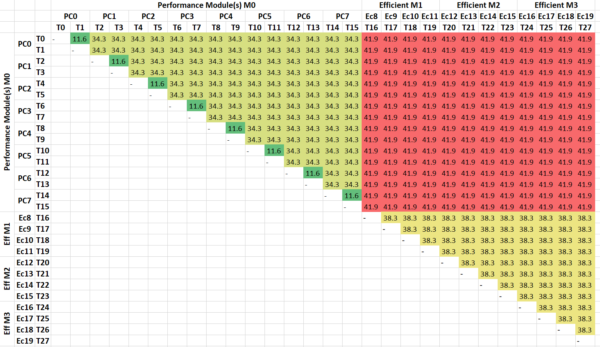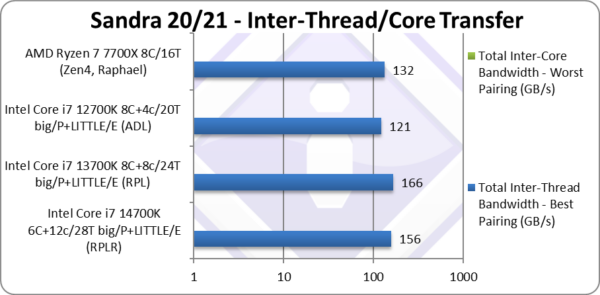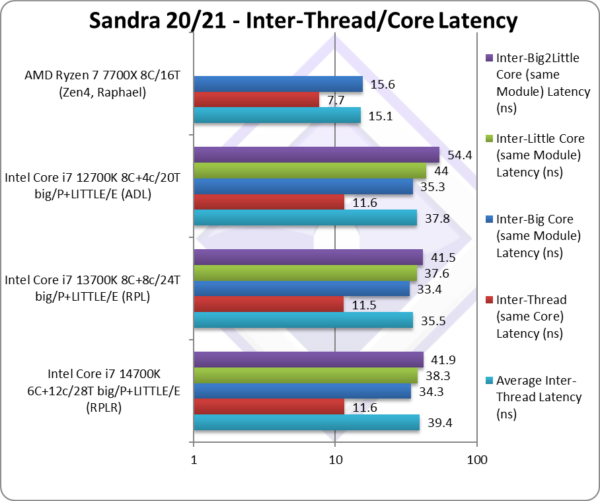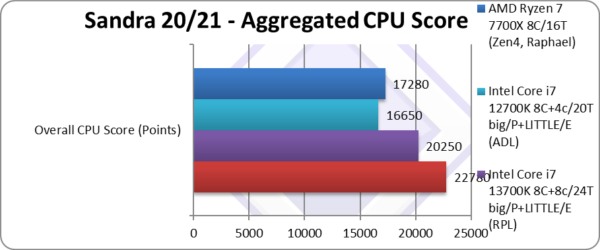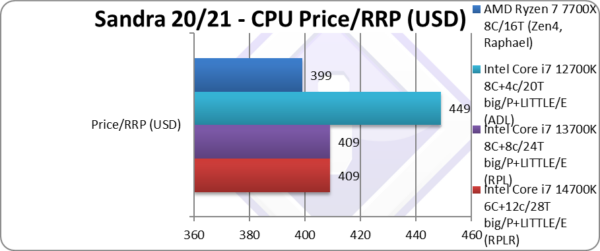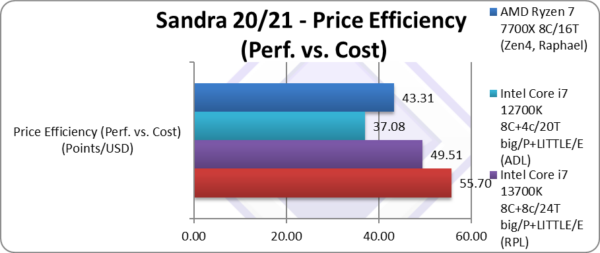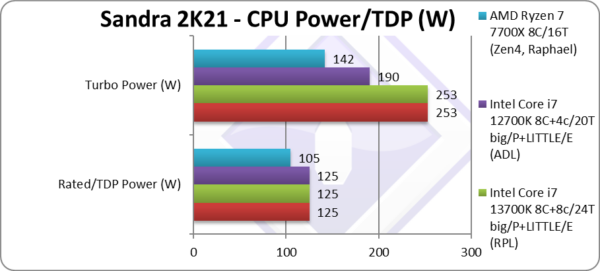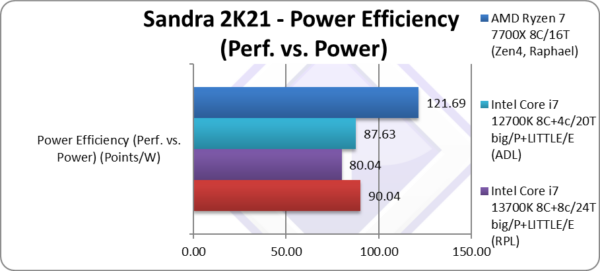What is “RaptorLake-Refresh”?
It is the “next-generation” (14th gen) Core architecture, refreshing the current “RaptorLake” (13th gen) and thus the 4th generation “hybrid” (aka “big.LITTLE”) arch that Intel has released. As before, it combines big/P(erformant) “Core” cores with LITTLE/E(fficient) “Atom” cores in a single package and covers everything from desktops, laptops, tablets and even (low-end) servers.
- Desktop (S) (65-125W rated, up to 253W turbo)
- 8C (aka big/P) + 16c (aka LITTLE/E) / 32T total (14th Gen Core i7-14900K(F))
- +50% as many LITTLE/E cores as RPL (14th Gen Core i7-14700K(F))
For best performance and efficiency, this does require operating system scheduler changes – in order for threads to be assigned on the appropriate physical core/thread. For compute-heavy/low-latency this means a “big/P” core; for low compute/power-limited this means a “LITTLE/E” core.
In the Windows world, this means “Windows 11” for clients and “Windows Server vNext” (note not the recently released Server 2022 based on 21H2 Windows 10 kernel) for servers. The Windows power plans (e.g. “Balanced“, “High Performance“, etc.) contain additional settings (hidden), e.g. prefer (or require) scheduling on big/P or LITTLE/E cores and so on. But in general, the scheduler is supposed to automatically handle it all based on telemetry from the CPU.
Windows 11 also gets updated QoS (Quality of Service) API (aka functions) allowing app(lications) like Sandra to indicate which threads should use big/P cores and which LITTLE/E cores. Naturally, these means updated applications will be needed for best power efficiency.
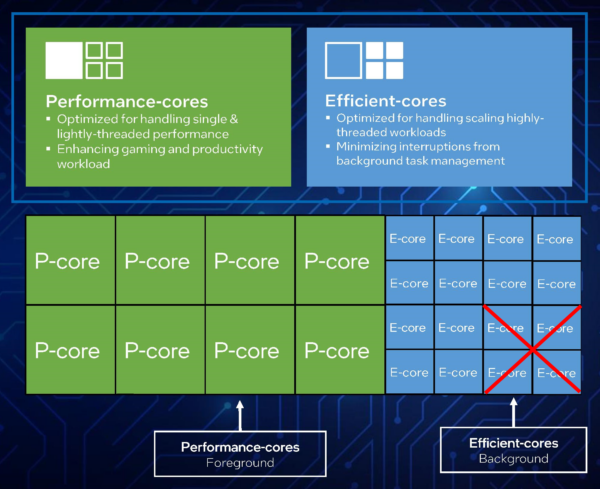
Intel Core i7 14700K(F) (RaptorLake-Refresh) 8C + 12c
General SoC Details
- 10nm+++ (Intel 7+) improved process
- Unified 33MB L3 cache (vs. 30MB on RPL thus 10% larger e.g. 14700K(F))
- PCIe 5.0 (up to 64GB/s with x16 lanes) – up to x16 lanes PCIe5 + x4 lanes PCIe4
- NVMe SSDs may thus be limited to PCIe4 or bifurcate main x16 lanes with GPU to PCIe5 x8 + x8
- PCH up to x12 lanes PCIe4 + x16 lanes PCIe3
- CPU to PCH DMI 4 x8 link (aka PCIe4 x8)
- DDR5/LP-DDR5 memory controller support (e.g. 4x 32-bit channels) – up to 5600Mt/s (official, vs. 4800Mt/s ADL)
- XMP 3.0 (eXtreme Memory Profile(s)) specification for overclocking with 3 profiles and 2 user-writable profiles (!)
- Thunderbolt 4 (and thus USB 4)
big/P(erformance) “Core” core
- Up to 8C/16T “Raptor Cove” (!) cores – improved from “Golden Cove” in ADL 😉
- Disabled AVX512! in order to match Atom cores (on consumer)
- (Server versions ADL-EX support AVX512 and new extensions like AMX and FP16 data-format)
- Single FMA-512 unit (though disabled)
- SMT support still included, 2x threads/core – thus 16 total
- L1I remains at 32kB
- L1D remains at 48kB
- L2 increased to 2MB per core (almost 2x ADL) like server parts (ADL-EX)
LITTLE/E(fficient) “Atom” core
- Up to 12c/12T “Gracemont” cores – thus 2x more than ADL but same core
- No SMT support, only 1 thread/core – thus 16 total (in 4x modules of 4x threads)
- AVX/AVX2 support – first for Atom core, but no AVX512!
- (Recall that “Phi” GP-GPU accelerator w/AVX512 was based on Atom core)
- L1I still at 64kB
- L1D still at 32kB
- L2 4MB shared by 4 cores (2x larger than ADL)
As with ADL/RPL, RPL-R’s big “Raptor Cove” cores have AVX512 disabled which may prove to be a (big) problem considering AMD’s current Zen4 (Ryzen 7000) range support it.
The changes from ADL to RPL were already minor (gen 12 to gen 13) but this time RPL-R is not even a new/updated RPL stepping – it is the very same silicon better binned for higher speeds. This must be the smallest difference between generations ever – even Gen 6 to 7 (“Skylake” SKL to “Kaby Lake” SKL) or Gen 9 to 10 (“Coffee Lake” CFL to “Comet Lake” CML) had more changes.
The only “interesting” CPU in the line-up is the 14700K(F) that comes with extra Efficient (Atom) cores (12 vs. 8) that is why it is the only CPU tested. Otherwise, all the other CPUs (14900K(F), 14600K(F) are just faster variants and that’s it.
Changes in Sandra to support Hybrid
Like Windows (and other operating systems), we have had to make extensive changes to both detection, thread scheduling and benchmarks to support hybrid/big-LITTLE. Thankfully, this means we are not dependent on Windows support – you can confidently test AlderLake on older operating systems (e.g. Windows 10 or earlier – or Server 2022/2019/2016 or earlier) – although it is probably best to run the very latest operating systems for best overall (outside benchmarking) computing experience.
- Detection Changes
- Detect big/P and LITTLE/E cores
- Detect correct number of cores (and type), modules and threads per core -> topology
- Detect correct cache sizes (L1D, L1I, L2) depending on core
- Detect multipliers depending on core
- Scheduling Changes
- “All Threads (MT/MC)” (thus all cores + all threads – e.g. 32T
- “All Cores (MC aka big+LITTLE) Only” (both core types, no threads) – thus 24T
- “All Threads big/P Cores Only” (only “Core” cores + their threads) – thus 16T
- “big/P Cores Only” (only “Core” cores) – thus 8T
- “LITTLE/E Cores Only” (only “Atom” cores) – thus 16T
- “Single Thread big/P Core Only” (thus single “Core” core) – thus 1T
- “Single Thread LITTLE/E Core Only” (thus single “Atom” core) – thus 1T
- “All Threads (MT/MC)” (thus all cores + all threads – e.g. 32T
- Benchmarking Changes
- Dynamic/Asymmetric workload allocator – based on each thread’s compute power
- Note some tests/algorithms are not well-suited for this (here P threads will finish and wait for E threads – thus effectively having only E threads). Different ways to test algorithm(s) will be needed.
- Dynamic/Asymmetric buffer sizes – based on each thread’s L1D caches
- Memory/Cache buffer testing using different block/buffer sizes for P/E threads
- Algorithms (e.g. GEMM) using different block sizes for P/E threads
- Best performance core/thread default selection – based on test type
- Some tests/algorithms run best just using cores only (SMT threads would just add overhead)
- Some tests/algorithms (streaming) run best just using big/P cores only (E cores just too slow and waste memory bandwidth)
- Some tests/algorithms sharing data run best on same type of cores only (either big/P or LITTLE/E) (sharing between different types of cores incurs higher latencies and lower bandwidth)
- Reporting the Performance Contribution & Ratio of each thread
- Thus the big/P and LITTLE/E cores contribution for each algorithm can be presented. In effect, this allows better optimisation of algorithms tested, e.g. detecting when either big/P or LITTLE/E cores are not efficiently used (e.g. overloaded)
- Dynamic/Asymmetric workload allocator – based on each thread’s compute power
As per above you can be forgiven that some developers may just restrict their software to use big/Performance threads only and just ignore the LITTLE/Efficient threads at all – at least when using compute heavy algorithms.
For this reason we recommend using the very latest version of Sandra and keep up with updated versions that likely fix bugs, improve performance and stability.
But is it RaptorLake-Refresh, RaptorLake or even AlderLake-Refresh?
Unfortunately, it seems that not all CPUs labelled “13th Gen” will be “RaptorLake” (RPL); some middle-range i5 and low-range i3 models come with “AlderLake” (Refresh) ADL-R cores that is likely to confuse ordinary people into buying these older-gen CPUs.
What is more confusing is that the ID (aka CPUID) of these 13th Gen ADL-R/RPL models is the same (e.g. 0B067x) and does not match the old ADL (e.g. 09067x). However, the L2 cache sizes are the same as old ADL (1.25MB for big/Core and 2MB for LITTLE/Atom cluster) not the larger RPL (2MB for big/Core and 4MB for LITTLE/Atom cluster).
Note: There is still a possibility these are actually RPL cores but with L2 cache(s) reduced (part disabled/fused off) in order not to outperform higher models.
CPU (Core) Performance Benchmarking
In this article we test CPU core performance; please see our other articles on:
- CPU
- Intel 13th Gen Core RaptorLake (i9 13900K(F)) Review & Benchmarks – High-End Hybrid
- Intel 13th Gen Core RaptorLake (i5 13600K(F)) Review & Benchmarks – Mid-Range Hybrid
- Intel 13th Gen Core RaptorLake? AlderLake? (i5 13400) Review & Benchmarks – Value Hybrid Efficiency
- Intel 12th Gen Core AlderLake Mobile (i7-12700H) Review & Benchmarks – big/LITTLE Performance
- Cache & Memory
- GP-GPU
Hardware Specifications
We are comparing the Intel with competing desktop architectures as well as competitors (AMD) with a view to upgrading to a top-of-the-range, high performance design.
| Specifications | Intel Core i7 14700K(F) 8C+12c/28T (RPL-R) | Intel Core i7 13700K(F) 8C+8c/24T (RPL) | Intel Core i7 12700K(F) 8C+4c/20T (ADL) | AMD Ryzen 7 7700X 8C/16T (Zen4) | Comments | |
| Arch(itecture) | Raptor Cove + Gracemont / RaptorLake Refresh | Raptor Cove + Gracemont / RaptorLake | Golden Cove + Gracemont / AlderLake | Zen4 / Raphael | The very latest arch | |
| Modules (CCX) / Cores (CU) / Threads (SP) | 8C+12c / 28T | 8C+8c / 24T | 8C+4c / 20T | 8C / 16T | 8 more (2x) LITTLE cores! | |
| Rated/Turbo Speed (GHz) | 2.5 – 4.3GHz [E] / 3.4 – 5.6GHz [P] [+3.7%] | 2.5 – 4.2GHz [E] / 3.4 – 5.4GHz [P] | 2.7 – 3.8GHz [E] / 3.6 – 5GHz [P] | 4.5 – 5.4GHz | Turbo is about 4% higher | |
| Rated/Turbo Power (W) |
125 – 253W [PL2] | 125 – 253W [PL2] | 125 – 190W [PL2] | 105 – 142W [PPL] | Same ratings | |
| L1D / L1I Caches | 8x 48/32kB + 12x 32/64kB |
8x 48/32kB + 8x 32/64kB | 8x 48/32kB + 4x 32/64kB | 8x 32kB 8-way / 8x 32kB 8-way | Same L1D/L1I caches | |
| L2 Caches | 8x 2MB + 3x 4MB (28MB) [+16%] |
8x 2MB + 2x 4MB (24MB) | 8x 1.25MB + 2MB (12MB) | 8x 1MB 16-way (8MB) | L2 is 16% larger |
|
| L3 Cache(s) | 33MB 16-way [+10%] | 30MB 16-way | 25MB 16-way | 32MB 16-way | L3 is 10% larger | |
| Microcode (Firmware) | 0B0671-11D | 0B0671-10E | 090672-1E | A20F10-1003 | Revisions just keep on coming. | |
| Special Instruction Sets | VNNI/256, SHA, VAES/256 | VNNI/256, SHA, VAES/256 | VNNI/256, SHA, VAES/256 | AVX512, VNNI/512, SHA, VAES/512 | AVX512 still MIA | |
| SIMD Width / Units |
256-bit | 256-bit | 256-bit | 512-bit (as 2x 256-bit) | Same SIMD units | |
| Price / RRP (USD) |
$409 | $409 | $449 | $399 | Same price | |
Disclaimer
This is an independent review (critical appraisal) that has not been endorsed nor sponsored by any entity (e.g. Intel, etc.). All trademarks acknowledged and used for identification only under fair use.
And please, don’t forget small ISVs like ourselves in these very challenging times. Please buy a copy of Sandra if you find our software useful. Your custom means everything to us!
SiSoftware Official Ranker Scores
- Intel Core i9-14900K (8C + 16T / 32T)
- Intel Core i7-14700K (8C + 12T / 28T)
- Intel Core i5-14600K (6C + 8T / 20T)
Native Performance
We are testing native arithmetic, SIMD and cryptography performance using the highest performing instruction sets. “RaptorLake” (RPL) does not support AVX512 – but it does support 256-bit versions of some original AVX512 extensions.
Results Interpretation: Higher values (GOPS, MB/s, etc.) mean better performance.
Environment: Windows 11 x64 (22H2), latest AMD and Intel drivers. 2MB “large pages” were enabled and in use. Turbo / Boost was enabled on all configurations.
Final Thoughts / Conclusions
Summary: A Better Value High(er)-End: 7/10
The changes from ADL to RPL were already minor (12th to 13th) but this time RPL-R is not even a new/updated RPL stepping – it is the very same silicon better binned for higher speeds. This must be the smallest difference between generations ever !
On desktop, Intel has been stuck with a maximum of 8 big/P(erformance) Cores on high-end since 10th Gen (“Comet Lake”) while their competitor (AMD) has gone all the way up to 16. Intel had no choice but to increase the number of LITTLE/E(fficient) Atom cores to improve performance from generation to generation (12th to 13th and now 14th Gen). The “value” high-end i7 models have at least gained LITTLE/E(fficient) cores consistently, from 4 to 8 (2x) and now to 12 (3x) with each generation getting that much closer to the i9 to leave the latter for bragging rights only (32-threads, count them! 😉
Thus RPL-R with higher clocks and 50% more LITTLE/E Atom cores ends up about 12% faster than RPL that allows it to win more benchmarks against AMD’s AVX512-enabled Zen4. For the same price and TDP that is not bad, but hardly revolutionary or even evolutionary. Considering it is the same stepping, with no other improvements or features whatsoever, it is somewhat disappointing.
But a gain (for the same money and power) is a gain and hopefully this also drives down the prices of “old” RPL (13th gen) and even older ADL (12th gen) that would represent better value if discounted by 15% or more. With Black Friday round the corner, there may be good deals to be had.
Summary: A Better Value High(er)-End: 7/10
Further Articles
Please see our other articles on:
- CPU
- Intel 13th Gen Core RaptorLake (i9 13900K(F)) Review & Benchmarks – High-End Hybrid
- Intel 13th Gen Core RaptorLake (i5 13600K(F)) Review & Benchmarks – Mid-Range Hybrid
- Intel 13th Gen Core RaptorLake? AlderLake? (i5 13400) Review & Benchmarks – Value Hybrid Efficiency
- Intel 12th Gen Core AlderLake Mobile (i7-12700H) Review & Benchmarks – big/LITTLE Performance
- Cache & Memory
- GP-GPU
Disclaimer
This is an independent review (critical appraisal) that has not been endorsed nor sponsored by any entity (e.g. Intel, etc.). All trademarks acknowledged and used for identification only under fair use.
And please, don’t forget small ISVs like ourselves in these very challenging times. Please buy a copy of Sandra if you find our software useful. Your custom means everything to us!

